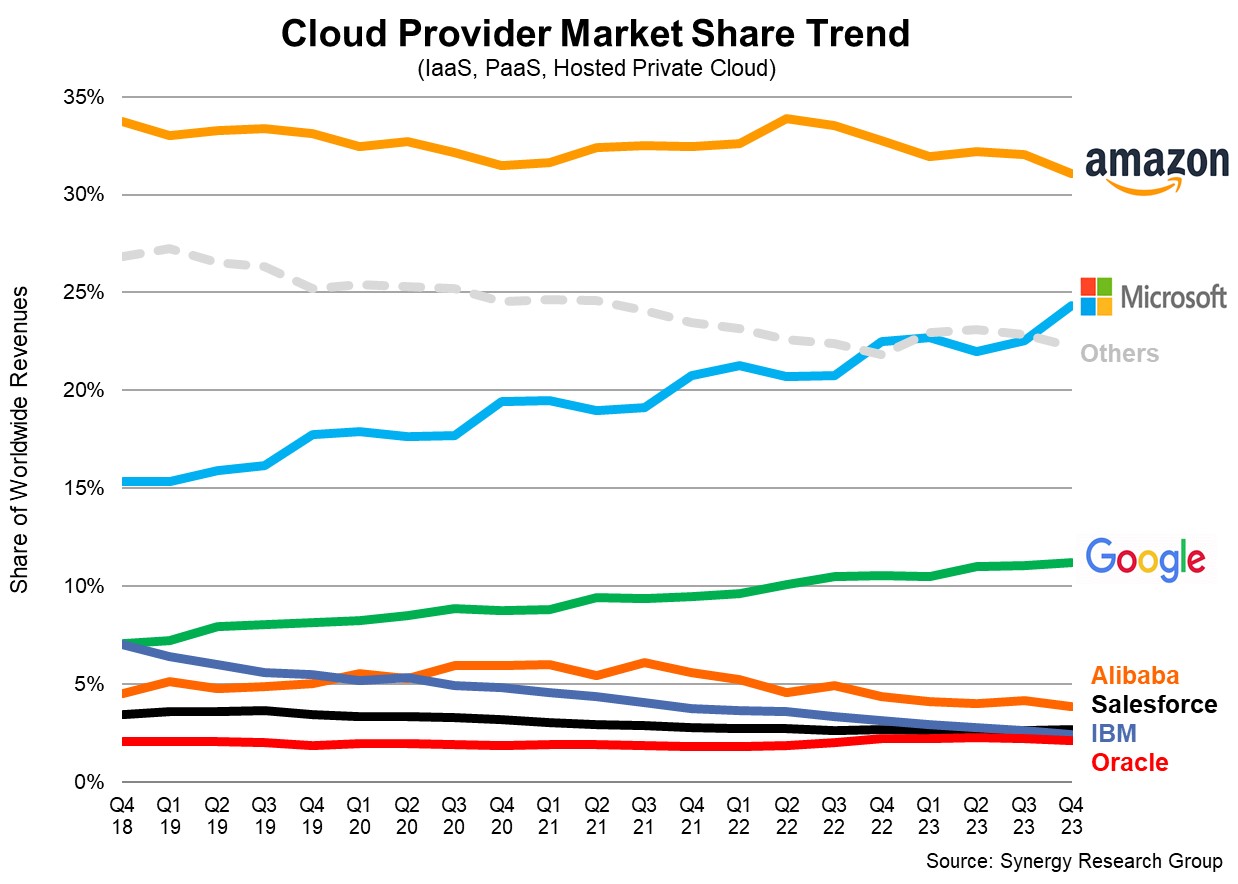For the last several quarters we’ve seen a lull in the expansion of the cloud infrastructure market, with lower growth numbers than we’ve been accustomed to seeing in the past. That changed this quarter thanks in large part to interest in generative AI. The new revenue wave began just last year, driven by the ChatGPT hype cycle, but has already pushed cloud infra revenue in the fourth quarter of 2023 to $74 billion, up $12 billion over last year at this time and $5.6 billion over Q3, the largest quarter-over-quarter increase the cloud market has experienced, per Synergy Research.
The cloud infrastructure market for the entire year grew to an eye popping $270 billion, up from $212 billion in 2022. Synergy’s John Dinsdale predicts that the growth we saw in the last year is here to stay, even as the market continues to mature and the law of large numbers takes increasing effect. “Cloud is now a massive market and it takes a lot to move the needle, but AI has done just that. Looking ahead, the law of large numbers means that the cloud market will never return to the growth rates seen prior to 2022, but Synergy does forecast that growth rates will now stabilize, resulting in huge ongoing annual increases in cloud spending,” he said in a statement.
Jamin Ball, a partner at Altimeter Capital, writing in his excellent Clouded Judgement newsletter, sees a similarly bright future for these vendors:
The hyperscalers are really starting to see the tailwind of new workload growth overtake the headwind of optimizations. Sometimes new workloads are AI related. Sometimes they’re classic cloud migrations. The hyperscalers benefit from massive scale, distribution, trust and depth of customer relationships in ways no other software companies do. They also are seeing AI revenue (largely compute) show up sooner than anyone else.
Ball’s data supports Dinsdale’s claims around diminishing growth rates, but in a market so large, growth for growth’s sake becomes a far less important metric:

Image Credits: Jamin Ball, Clouded Judgement, Altimeter Capital
For now, it appears that Microsoft’s lucrative investment/partnership with OpenAI is giving it an edge in the market as we saw the company’s market share grow two full percentage points to 25% in the fourth quarter, a remarkable one-quarter increase. Amazon is still king of the mountain with 31% share, albeit down two points from last quarter. It would be easy to say Amazon’s loss was Microsoft’s gain, although it’s probably not quite that simple and there are probably more nuanced impacts across the market. Meanwhile Google held steady at around 11% share.
Synergy reports that the Big 3 constitute 67% of overall market share, or approximately $50 billion in total cloud revenue coming from the three largest companies for a single quarter.
From a dollars perspective, the numbers are, per usual, a bit mind boggling, with Amazon coming in at $23 billion, Microsoft at $18.5 billion and Google with around $8 billion. If these numbers don’t match the reported numbers exactly, that’s because these companies often combine different types of cloud revenue to arrive at the reported figures. Synergy looks at IaaS, PaaS and hosted private cloud services, and the companies’ reported cloud numbers may include SaaS and other revenue that Synergy doesn’t count.

Image Credits: Synergy Research
In terms of quarterly percentage growth, keeping in mind those caveats about how the companies measure revenue, AWS was up 13%, Azure was up 30% and Google Cloud was up around 25% (although they don’t separate out SaaS revenue in that number).
One thing was clear last year, Microsoft was putting the heat on Amazon and left the company on its heels, perhaps for the first time, with its aggressive deal making with OpenAI.
Scott Raney, a partner at Redpoint, told TechCrunch at re:Invent in December that Amazon was clearly playing catch up when it came to AI, and it was an unusual place for the company to find itself. “This might be the first time where people looked and said that Amazon isn’t in the pole position to capitalize on this massive opportunity. What Microsoft’s done around Copilot and the fact Q comes out [this week] means that in reality, they’re absolutely 100% playing catch-up,” Raney said at the time.
While generative AI represents a massive opportunity for all the cloud vendors, it’s still very much early days. We always like to say that first to market is a huge advantage, and it certainly has been for Amazon all these years. Whether Microsoft’s aggressive approach to AI represents a similar advantage isn’t clear yet, but it’s hard to ignore a two percentage point market share increase in a single quarter. For now it feels like Microsoft has taken the lead when it comes to AI in the enterprise, but Google and Amazon still have plenty of time left on the clock to figure it out.
